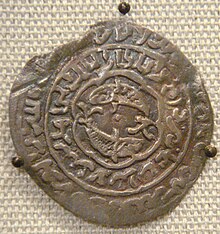Al-Ashraf Umar II
Umar Ibn Yussuf | |
|---|---|
 Coin of the Rasulids in 1335. | |
| Born | circa 1242 Yemen |
| Died | 22 November 1296 Yemen |
| Scientific career | |
| Fields | Astronomy, Mathematician and Physician |
Al‐Malik Al‐Ashraf (Mumahhid Al‐Din) Umar Ibn Yūsuf Ibn Umar Ibn Alī Ibn Rasul (Arabic: عمر بن يوسف بن عمر بن علي بن رسول الغساني), also as Umar Ibn Yusuf (or also Al-Asharaf Umar II) was the third Rasulid sultan and also an mathematician, astronomer and physician.
Biography

Umar Ibn Yusuf was born in 1242 in Yemen and he died in 1296. [2] He is known for writing the first description of the use of a magnetic compass for determining the qibla.[1] Also, his works on astronomy contain important information on earlier sources.[1]
In a treatise about astrolabes and sundials, al-Ashraf includes several paragraphs on the construction of a compass bowl (ṭāsa). He then uses the compass to determine the north point, the meridian (khaṭṭ niṣf al-nahār), and the Qibla towards Mecca. This is the first mention of a compass in a medieval Islamic scientific text and its earliest known use as a qibla indicator, although al-Ashraf did not claim to be the first to use it for this purpose.[1]
We owe him a famous astrolabe made in 1291, actually in the New York Metropolitan Museum of Art.[3]
Notes
- ^ a b c d Schmidl, Petra G. (1996–97). "Two Early Arabic Sources On The Magnetic Compass". Journal of Arabic and Islamic Studies. 1: 81–132. http://www.uib.no/jais/v001ht/01-081-132schmidl1.htm#_ftn4 Archived 2014-09-02 at the Wayback Machine
- ^ Schmidl 2007.
- ^ MET picture. — Sharon Kinoshita The Painter, the Warrior, and the Sultan: The World of Marco Polo in hree Portraits, The Medieval Globe, vol. 2, n° 1, 2016, p. 120 sq.
References
- Schmidl, Petra G. (2007). "Ashraf: al‐Malik al‐Ashraf (Mumahhid al‐Dīn) ʿUmar ibn Yūsuf ibn ʿUmar ibn ʿAlī ibn Rasūl". In Thomas Hockey; et al. (eds.). The Biographical Encyclopedia of Astronomers. New York: Springer. pp. 66–7. ISBN 9780387310220. (PDF version)
